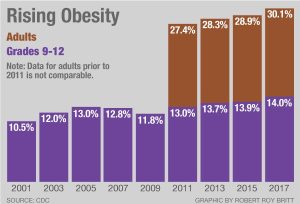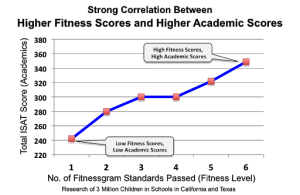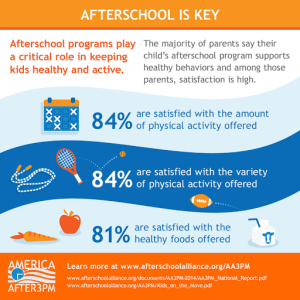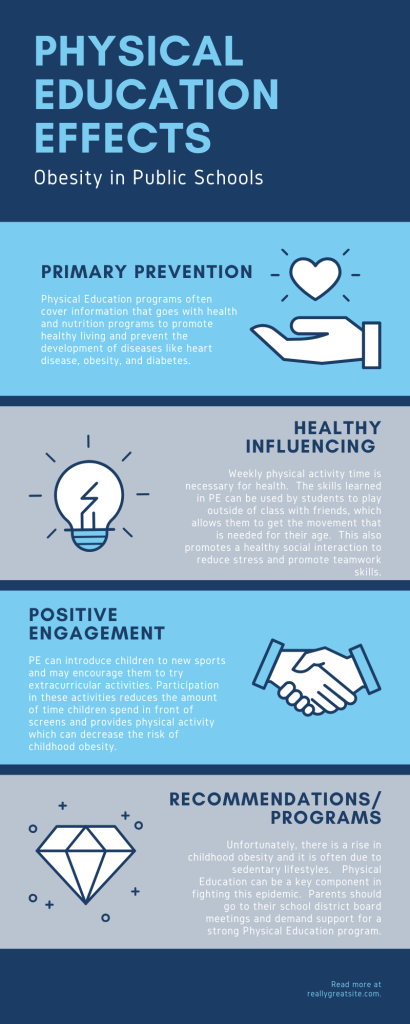16
Chris Matlashewski
The Importance of Physical Education
Physical education in public schools is a stepping stone for promoting physical activity and for encouraging children to have healthier lifestyles. These programs require children to get active, allowing them to fulfill most of their weekly physical activity recommendations. Physical education programs are like a multivitamin for children growing up; they can help them grow strong and healthy. Not only does it allow them to increase their physicality, but also gives children basic activities that they can perform later on with friends and family. With that being said, physical education programs in public schools have major issues regarding funding, participation, and low curriculum time. This is causing a decline in the quality of programs and in some instances programs are being removed from schools and replaced with online physical education.

Public School Budgets
Budgets for public schools are normally limited and can be very hard to provide for most of the needs of schools. This can vary depending on the sociodemographic factors that play in with the school’s location. Sociodemographic factors include age, sex, education, migration background and ethnicity, religious affiliation, marital status, household, employment, and income. With a lot of the budget funding decisions based on standardized tests that hold students to be accountable, physical education and recess are often overlooked when money comes available in the budget (Story et al., 2006). Even though these programs are proven to decrease obesity rates and improve grades, school district administrators do not prioritize physical education programs as an academic strategy or obesity prevention tool. So instead, funding is used to change the food environment in the schools thinking that changing students’ eating habits will be a better prevention strategy to fight obesity.

Funding for these programs can also become an issue with the sociodemographic factors where the school is located. Different school districts depending on their area can have higher or lower budgets per school. This means that a child going to school in a poor rural area can have an increased chance of becoming obese because of the lack of money to fund a decent physical education program. Facilities, equipment, and high enrollment can all part of the difficulties of a physical education program for a poorer school. Unfortunately, these children have a decreased chance to participate in physical activity in school and limited knowledge on how to get physical activity outside of school.
Creating Guidelines
Physical education guidelines are usually set by state officials when it comes to public schools. When creating the rules on what each school must cover, state officials usually only require the minimum. By doing this, it leaves a lot of room for school districts to take action on what they want their schools to do, which is usually less than the nationally recommended amount of exercise. These programs are failing to meet the recommendations of the Surgeon General and The Centers for Disease Control and Prevention (CDC) for daily physical education (Hayne et al., 2004). People get upset and argue that this is the fault of the state and the state officials, but it mainly comes down to the school districts. School districts are the enforcers in this situation but too many let these programs fail, resulting in increased childhood obesity. District officials tend to overlook the value that these physical education programs have and reduce the time given for the program to be replaced by more time for subjects that are part of standardized testing. Physical education programs can be costly for the schools, but ultimately influence a healthier lifestyle and prevent less spending on health care for children growing up.
Obesity is one of the CDC’s top priorities and school districts play a part in fighting this epidemic. Obstacles such as limited recess, less physical education, restricted playing, etc have been shown to promote and increase the chances of a sedentary lifestyle, which limits the amount of physical activity a child gets (Bocarro et al., 2004). If school districts increase physical education quality and quantity, it leads to increased involvement in extracurricular sports, more active lifestyles, and fewer future health problems.
Nutrition and Health Programs

School districts must combine their physical education programs with their nutrition and health education programs. Nutrition and health promotion aspects of physical activity are very important for children to understand as they grow into young adults. During the adolescent and teenage years, students tend to make more of their own eating choices. A physical education curriculum can provide children with the knowledge of what they need to consume in order to stay fit and healthy. Unfortunately, only approximately half of elementary through middle schools require nutrition education along with physical education. When administrators make the hard decision to cut PE programs, health education programs often get cut as well. This correlates to an increase in obesity rate and federal spending on health-related issues.
Nutrition services are often determined by school districts following federal guidelines (read the next chapter to learn more about School Nutrition). Unfortunately, some public schools trying to regulate the school food environment do not have the equipment to create appealing and tasty meals for their students which can lead to increased vending machine use. Nutrition education can help students make better food choice decisions and help them take steps toward healthier living.
Summary
School districts need to embrace helping their community fight the growing numbers of childhood obesity. Most districts are not adequately funding the programs that can fight obesity. Physical education programs should be at the top of their list to help children in their district decrease their chances of obesity-related diseases. Schools can influence a child’s eating, drinking, and fitness habits with good physical and health education programs. These programs can teach life skills that will help children be directed on a healthier, happier path. The following infographic summarizes the points explained in this chapter.

Review Questions
References
Bocarro, J., Kanters A. M., Casper, J., & Forrester, S. (2008). School physical education, extracurricular sports, and lifelong active living. Journal of Teaching in Physical Education, 27(2), 155-166. https://doi.org/10.1123/jtpe.27.2.155
Cale, L., & Harris, J. (2011). Every child (of every size) matters in physical education! Physical education role in childhood obesity. Sports, Education and Society, 18(4), 433-452. https://doi.org/10.1080/13573322.2011.601734
Fernandes, M. & Sturm, R. (2010). Facility provision in elementary school: Correlates with physical education, recess, and obesity. Preventive Medicine, 50(1), 30-35. https://doi.org/10.1016/j.ypmed.2009.09.022
Hayne, L. C., Moran A. P., & Ford, M. M. (2004). Regulating environments to reduce obesity. Journal of Public Health Policy, 25(3-4), 391-407. https://doi.org/10.1057/palgrave.jphp.3190038
Kim, J. (2012, May 8). Are physical education‐related state policies and schools’ physical education requirements related to children’s physical activity and obesity?. Journal of School Health, 82(6), 268-276. https://doi.org/10.1111/j.1746-1561.2012.00697.x
McKenzie, T. L., & Lounsbery, M. A. F. (2009). School physical education: The pill not taken. American Journal of Lifestyle Medicine, 3(3), 219-225. https://doi.org/10.1177/1559827609331562
Story, M., Kaphingst, M. K., & French, S. (2006). The role of schools in obesity prevention. Future Child, 16(1), 110-141. https://doi.org/10.1353/foc.2006.0007
of, relating to, or involving a combination of social and demographic factors
the chief medical officer of a branch of the armed services or of a public health service
doing or requiring much sitting
